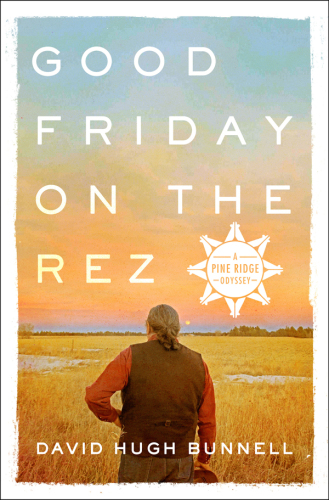
Good Friday on the Rez
A Pine Ridge Odyssey
کتاب های مرتبط
- اطلاعات
- نقد و بررسی
- دیدگاه کاربران
نقد و بررسی

Starred review from November 28, 2016
Tech pioneer, author, and activist Bunnell (who died in October) has written a melancholy and fascinating account of a 280-mile road trip from his boyhood home of Alliance, Neb., to the Pine Indian Reservation, a journey that takes him through dramatic terrain and landmarks from the tragic history of the Lakota tribes. Bunnell, a small-town kid who became an idealistic schoolteacher on the reservation, smuggled food to protestors during the 1973 siege at Wounded Knee and developed a lifelong friendship with the charismatic Vernell White Thunder, a direct descendant of Oglala Lakota chiefs and medicine men. In vivid prose, Bunnell weaves memories of his childhood and youth with a sweeping history of the Lakota during and since white expansion into the west—from the U.S. army massacres of women and children, the battle at Little Bighorn, and the murder of Crazy Horse, to present-day struggles with poverty, racism, and alcohol. White Thunder’s family anecdotes and successful efforts to merge his heritage and the modern world, as Bunnell, explains, provide an inspiring counterpoint to the nightmare of history. After receiving a terminal cancer diagnosis, Bunnell devoted himself to completing this account, and it stands as a tribute to a seemingly defeated people who recovered their pride in the Wounded Knee standoff.

February 15, 2017
An Indian rights sympathizer returns to the site of an iconic moment in Native American resistance: Wounded Knee.Bunnell, a white native of Alliance, Nebraska--what he calls "the most boring town in America," though not without affection--grew up around Sioux people, though often the rootless, wandering, and drunken kind that filled the town's back alleys, jail, and morgue. The kind he encountered when the American Indian Movement rose up in 1973 at Wounded Knee, South Dakota, the site of the last major massacre in the Indian Wars, were a different sort, muscular, disciplined, and well-armed--"long-haired big-city Indians," he writes, "some with revolvers tucked in the waistbands of their blue jeans." The young Bunnell cut his teeth bringing in supplies, questioned by a vigorous security force whether his intention was to poison the activists but then allowed to come and go. Here he recounts those episodes, mixing them with anecdotes about the people he met on the scene and what has become of them, as well as what has become of the entire Lakota Nation at Pine Ridge, a place as remote as any on the continent, just this side of the "North American pole of inaccessibility." That puts places like Pine Ridge, Kyle, and Wounded Knee out of view of most wasicus, or white people, and even if Bunnell insists that "everyone should come to Wounded Knee at least once," this little travelogue by way of memoir is about as close as most readers will get. The author's constant asides on the virtues and demerits of small-town life ("name a fancy New York restaurant that offers you the choice of three outstanding side dishes with every entree") can be a little much, but his reports from the front line then and now are urgent and important. A well-intended memoir with forgivable flaws in the service of the greater good of delivering a portrait of reservation life over the course of half a century.
COPYRIGHT(2017) Kirkus Reviews, ALL RIGHTS RESERVED.

January 1, 2017
The late Bunnell, who was a prolific writer, activist, and journalist (most notably founding PC Magazine and Macworld), marries a heartfelt memoir with history, educating readers in both recent and past Native American lore, personal histories, inequalities, and traditions. His personal "odyssey" was in the form of a driving trip. Leaving from his childhood home in Nebraska and traveling to Pine Ridge Indian Reservation in South Dakota to visit a former student, Bunnell keenly and with arresting detail observes the towns he encounters, comparing both past and present. Interspersed throughout are histories of the massacres and the annihilation of Native populations and their food supplies in the late 1800s, along with Bunnell's experiences at Wounded Knee during the 1970s occupation and as a teacher at Pine Ridge. With honesty and sensitivity, the author does much to explain the plight and inequities encountered by Native American communities over many generations. VERDICT This informative account should be placed alongside all books on Native American history and culture. It deserves to be read by all, particularly in light of the recent Dakota Access Pipeline protests.--Maria Bagshaw, Elgin Community Coll. Lib., IL
Copyright 2017 Library Journal, LLC Used with permission.

March 1, 2017
Bunnell, writer and editor of several early tech magazines, returns to his roots in this emotional and eye-opening memoir. On a recent Good Friday, he makes the 280-mile journey north from Alliance, Nebraska, where he grew up, to the Pine Ridge Reservation in South Dakota, the poorest community in America, to visit his old friend, Vernell White Thunder, descendant of Oglala Lakota chiefs and medicine men. Bunnell's captivating account is comprised of a compelling melange of childhood memories, his years teaching on the reservation, and his presence at crucial moments in Native struggles, including the AIM standoff at Wounded Knee in 1973, when he smuggled food past government troops to the activists led by Russell Means. His descriptions of stops along his journey, from the plethora of bars in Whitebay, Nebraska, skid row of the plains, to the Sioux Nation Shopping Center stocked with over-the-hill produce and gray hamburger meat, leave indelible pictures in the reader's mind. Bunnell ends on a positive note as his friend Vernell assures him that Lakotas are again asserting their sovereignty, generations after Wounded Knee.(Reprinted with permission of Booklist, copyright 2017, American Library Association.)

























دیدگاه کاربران